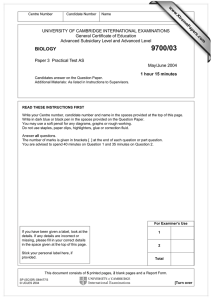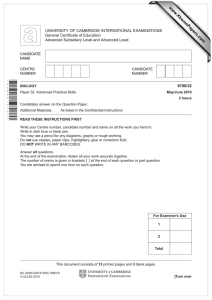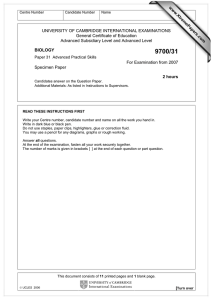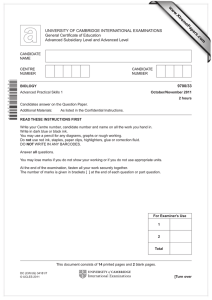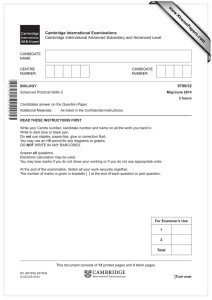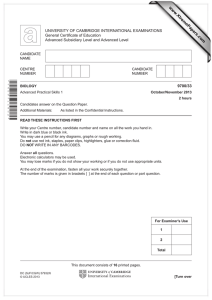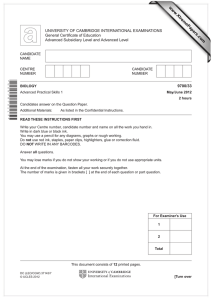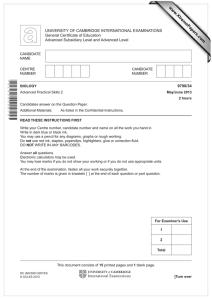www.XtremePapers.com
advertisement
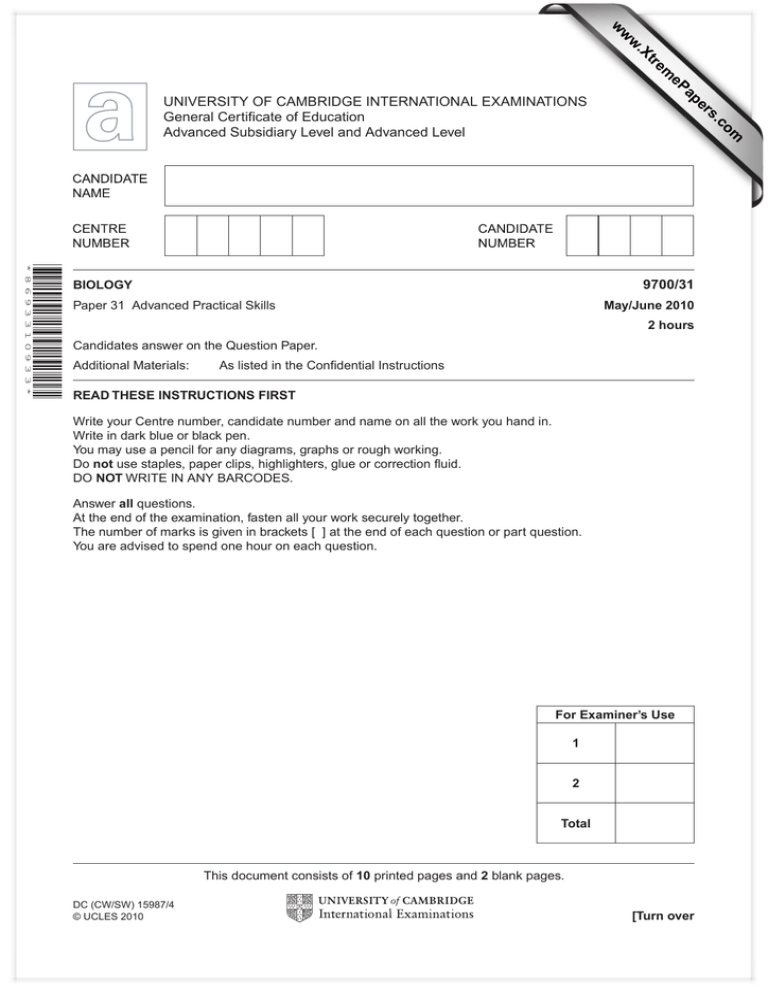
w w ap eP m e tr .X w om .c s er UNIVERSITY OF CAMBRIDGE INTERNATIONAL EXAMINATIONS General Certificate of Education Advanced Subsidiary Level and Advanced Level *8693310933* 9700/31 BIOLOGY Paper 31 Advanced Practical Skills May/June 2010 2 hours Candidates answer on the Question Paper. Additional Materials: As listed in the Confidential Instructions READ THESE INSTRUCTIONS FIRST Write your Centre number, candidate number and name on all the work you hand in. Write in dark blue or black pen. You may use a pencil for any diagrams, graphs or rough working. Do not use staples, paper clips, highlighters, glue or correction fluid. DO NOT WRITE IN ANY BARCODES. Answer all questions. At the end of the examination, fasten all your work securely together. The number of marks is given in brackets [ ] at the end of each question or part question. You are advised to spend one hour on each question. For Examiner’s Use 1 2 Total This document consists of 10 printed pages and 2 blank pages. DC (CW/SW) 15987/4 © UCLES 2010 [Turn over 2 You are reminded that you have only one hour for each question in the practical examination. You should read carefully through the whole of each question and then plan your use of the time to make sure that you finish all of the work that you would like to do. You will gain marks for recording your results according to the instructions. 1 The enzyme E catalyses the hydrolysis of sucrose to produce fructose and glucose. You are required to investigate the progress of this enzyme-catalysed reaction by finding the time taken for the decolourization of potassium permanganate. The products of the hydrolysis of sucrose will change the colour of potassium permanganate as follows: colourless purple Test-tube Z shows the colourless end-point. To follow the time course of this reaction take samples from the reaction mixture and test them with potassium permanganate. (a) (i) Decide how often you will take these samples. You should not sample for longer than 20 minutes. Write your sampling times in the space below. [2] © UCLES 2010 9700/31/M/J/10 For Examiner’s Use 3 (ii) Prepare the space below to record • • • For Examiner’s Use the time you remove each sample and the time at which the end-point is reached and the time taken to reach the end-point. [5] © UCLES 2010 9700/31/M/J/10 [Turn over 4 You are provided with • 1% enzyme solution, labelled E • 10 % sucrose solution, labelled S • 1 mol dm–3 sulfuric acid, labelled A • 0.01% potassium permanganate solution, labelled P. The sulfuric acid and potassium permanganate are harmful. If any comes into contact with your skin wash immediately under cold water. It is recommended that you wear safety goggles/glasses. Proceed as follows: 1. 2. 3. 4. 5. 6. 7. 8. Label the test-tubes with the sampling times that you have decided to use. Put 2.5 cm3 of A into each test-tube. Put 1 cm3 of P into each test-tube. Gently shake each test-tube. Put 30 cm3 of S into a beaker. Put 4 cm3 of E into the beaker containing S. Immediately stir the reaction mixture in the beaker and start timing. At each of your sampling times, remove 5 cm3 of the reaction mixture and add to the appropriate test-tube, mixing well. Immediately start timing and record the time taken to reach the end-point. (b) Describe a suitable control for this investigation. .......................................................................................................................................... ...................................................................................................................................... [1] (c) (i) Identify two significant sources of error in this investigation. ................................................................................................................................. ................................................................................................................................. ................................................................................................................................. ................................................................................................................................. ................................................................................................................................. ............................................................................................................................. [2] (ii) State one variable which was not controlled in this investigation and how it could have been controlled. ................................................................................................................................. ............................................................................................................................. [1] © UCLES 2010 9700/31/M/J/10 For Examiner’s Use 5 Table 1.1 shows the results for a similar investigation which measured the mass of reducing sugars produced over a period of 400 seconds. For Examiner’s Use Table 1.1 (d) (i) time /s mass of reducing sugars / mg 60 0.32 120 0.64 180 0.95 300 1.55 400 2.05 Plot a graph of the data shown in Table 1.1. [4] (ii) Use your graph to find the rate of hydrolysis of the sucrose by finding the gradient of the line. Show on your graph where you took the readings to calculate the gradient. [2] Show all the steps in your calculation. © UCLES 2010 rate of enzyme activity ...................................... mg s–1 [2] 9700/31/M/J/10 [Turn over 6 (iii) The student repeated the investigation for 600 seconds and found that the results for the enzyme-catalysed reaction between 60 and 400 seconds were similar to the results in Table 1.1 but after 400 seconds the mass of reducing sugars produced remained the same. Explain why the mass of reducing sugars increased and then remained the same. ................................................................................................................................. ................................................................................................................................. ................................................................................................................................. ................................................................................................................................. ............................................................................................................................. [2] [Total: 21] © UCLES 2010 9700/31/M/J/10 For Examiner’s Use 7 2 J1 is a slide of a stained transverse section showing a tubular part of the digestive system of a mammal. For Examiner’s Use You are not expected to have studied this material. Fig. 2.1 (a) Draw a large plan diagram of a quarter of the tube as shown in Fig. 2.1. Labels are not required. [4] © UCLES 2010 9700/31/M/J/10 [Turn over 8 Fig. 2.2 is a photomicrograph showing a transverse section through a different part of the digestive system in the same mammal, showing a number of similar structures. X x 50 Fig. 2.2 (b) (i) Calculate the actual length, shown by line X, of one of the structures. Show all the steps in your calculation. .............................................μm [2] (ii) Explain how you would find the mean length of the structures shown in Fig. 2.2. ................................................................................................................................. ................................................................................................................................. ................................................................................................................................. ................................................................................................................................. ............................................................................................................................. [2] © UCLES 2010 9700/31/M/J/10 For Examiner’s Use 9 (iii) Prepare the space below so that it is suitable for you to compare and contrast the specimen on J1 and that in Fig. 2.2. For Examiner’s Use Record your observations in the space you have prepared. [5] (iv) Suggest how the structures in Fig. 2.2 are adapted for absorption. ................................................................................................................................. ............................................................................................................................. [1] © UCLES 2010 9700/31/M/J/10 [Turn over 10 Fig. 2.3 is a photomicrograph showing some cells from the lining of the digestive system. For Examiner’s Use draw the cells in this sector Fig. 2.3 (c) Make a large, labelled drawing of the complete cells shown in the sector on Fig. 2.3. [5] [Total: 19] © UCLES 2010 9700/31/M/J/10 11 BLANK PAGE © UCLES 2010 9700/31/M/J/10 12 BLANK PAGE Copyright Acknowledgements: Figure 2.2 © Manfred Kage/Science Photo Library. Permission to reproduce items where third-party owned material protected by copyright is included has been sought and cleared where possible. Every reasonable effort has been made by the publisher (UCLES) to trace copyright holders, but if any items requiring clearance have unwittingly been included, the publisher will be pleased to make amends at the earliest possible opportunity. University of Cambridge International Examinations is part of the Cambridge Assessment Group. Cambridge Assessment is the brand name of University of Cambridge Local Examinations Syndicate (UCLES), which is itself a department of the University of Cambridge. © UCLES 2010 9700/31/M/J/10




